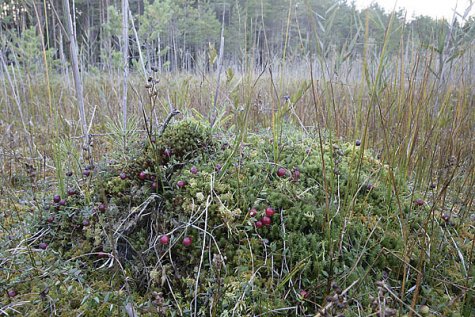Cranberry bog
Photo: Arne Ader
Translation: Liis
Tussock with cranberries. Quagmire shore at Lake Kisejärv
| Cranberry |
Harilik jõhvikas
|
Oxycoccus palustris |
The beautiful autumn weather is an invitation to go outside; next week there will be northerly winds and cold. The openess and peace of the cranberry mires and bog verges can still be pleasurably enjoyed this weekend.
The berry crop won’t be comparable to last year’s “cranberry deluge“, the yield is average or even somewhat below average. The cranberries flowered well in June, and there were enough pollinators too, but the summer drought reduced the size of the berries, in addition to various other problems. In some places for instance the cranberry bogs are drenched.
Let us then look at the creeping, thin-stemmed dwarf shrub of the cranberry, with the hair-like stalk that joins the berry to the stem. It has given the cranberry one of its Estonian names, jõhvikas from jõhv, horse hair.
During its first year of growth the stems are soft, during the second year they lignify and get scales like older twigs of other shrubs. The leaves are evergreen, glossy and less than a centimetre long.
The berries usually ripen about halfway into September, from then onwards it is worth picking the valuable and healthy “crane berries“. If picked earlier and left to ripen the taste will be poorer and their value for your health less. Berries that have had several night frosts taste better but keep less well.
The values of cranberries are appreciated by foxes, raccoon dogs and of course bears, for whom it is a source of vitamins to be stored in the organism during their autumn fattening-up period, as well as in the spring after waking up from the winter hibernation. In a good habitat one hectare can produce up to a ton of berries.









